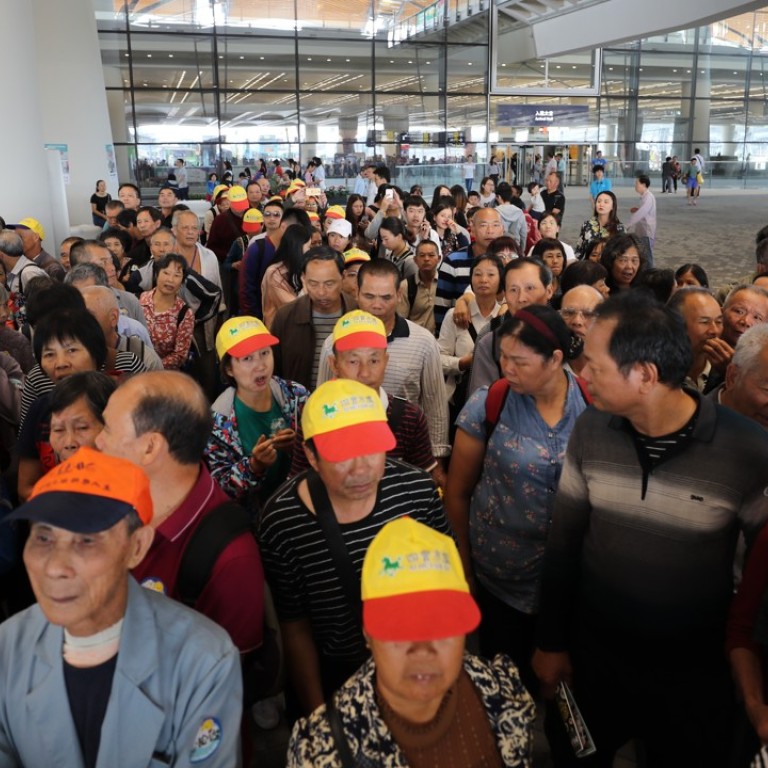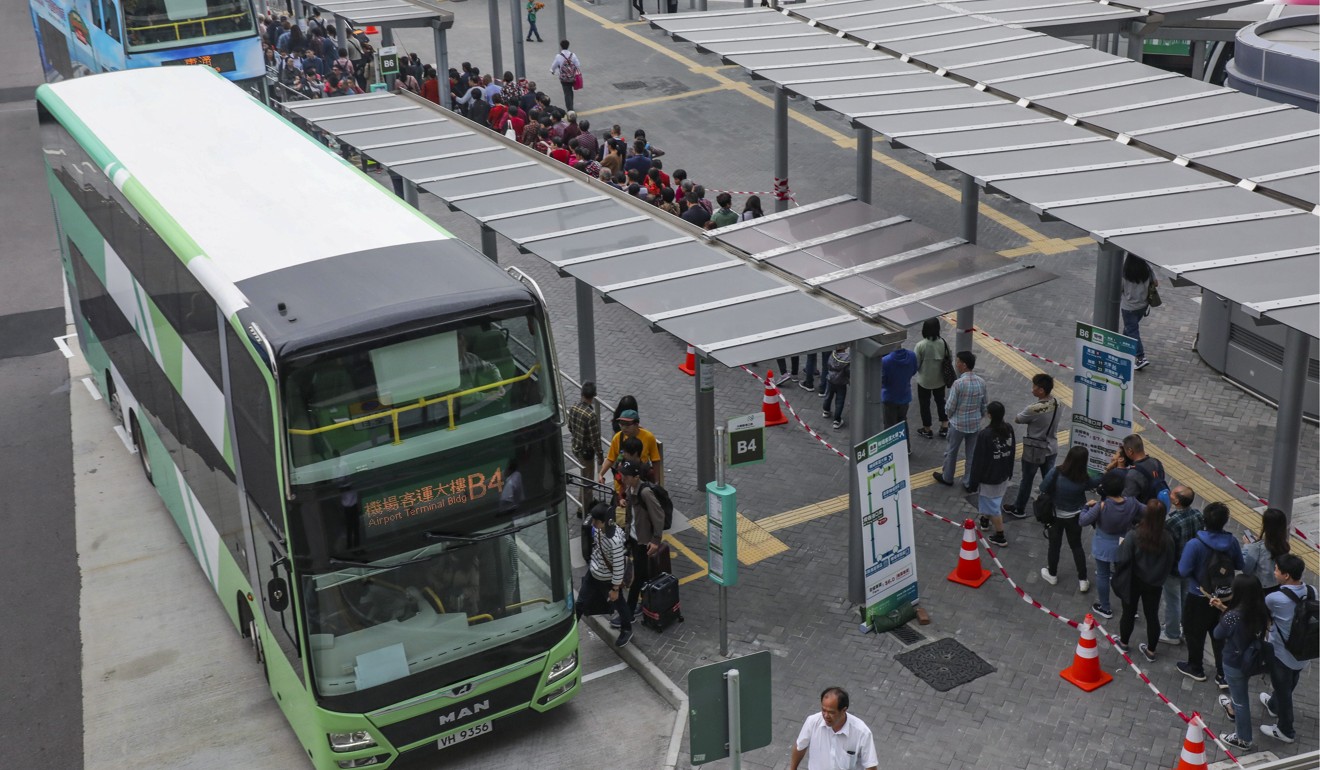
‘Signs of improvement’, but calls still stand for mall and car park at checkpoint of Hong Kong-Zhuhai-Macau Bridge to ease Tung Chung crowds
- Town beset by large tour groups, mostly from mainland China, since the bridge opened almost a month ago
- Residents report situation easing this weekend, although inbound visitor numbers at checkpoint still similar to previous weeks
Tung Chung, a residential area close to the port facility of the Hong Kong-Zhuhai-Macau Bridge, enjoyed a relatively peaceful weekend compared with last week when emotions boiled over amid local protests to reclaim the town from the flood of mainland visitors.
Wong Chun-yeung of local activist group Tung Chung Future said the number of tourists in the district had declined throughout this week and the area had become more orderly.

“If the situation continues to be like this, then we will not launch another reclaim movement,” he said.
Since the bridge opened last month, tour groups, mostly from mainland China, descended on the area as tens of thousands of day-trippers came in by public bus for shopping, dining and sightseeing, angering local residents.
Tung Chung resident Ricky Lam Ming-yip, 51, said he also felt the number of visitors had dropped, but eateries were still packed.
Tung Chung chaos: Appalling lack of vision on mega bridge tourist influx
NeoDemocrat Roy Tam Hoi-pong, however, warned that improvements felt in Tung Chung only meant the flow of visitors had been directed to other areas in Hong Kong, citing inbound figures at the bridge, which were “similar to last week”.
According to the Immigration Department, more than 103,000 people crossed the port area of the bridge on Saturday, a record high. They included 48,450 visitors entering the city and 54,781 leaving.
Last Saturday, more than 43,700 people came into Hong Kong via the bridge.
By 8pm on Sunday, about 91,200 had crossed the local port facility, among whom 47,864 were inbound travellers.
Hong Kong moves to tighten tour guide rules as visitors overwhelm
The Travel Industry Council said around 200 mainland tour groups in Hong Kong passed through the bridge on Sunday, up from about 90 a week earlier.
Tam suggested a bus route should be set up for tourists visiting an east artificial island on the mega crossing, so that they would not need to enter the city. The island is part of the bridge structure and before the Hong Kong port facility. “The bus service can cut the inflow of visitors by half,” Tam said.
“A lot of elderly visitors from the mainland only come in and sit on chairs in Tung Chung. They don’t have a desire to walk or enter the shopping malls. They just come as part of their wish to see the bridge,” he said, adding that a ticket quota could also be set for shuttle bus services between the three port areas on the bridge.
A lot of elderly visitors from the mainland only come in and sit on chairs in Tung Chung. They don’t have a desire to walk or enter the shopping malls
On Sunday morning, pro-establishment lawmaker Michael Tien Puk-sun called for a shopping mall and another car park to be built at the Hong Kong port over what he saw as failure by the government to provide sufficient facilities.
“The entire government bears the biggest responsibility,” Tien said on a radio programme.
He called for a car park with about 1,000 to 2,000 spaces, as well as a shopping mall of more than 1 million sq ft on the artificial island which houses the bridge’s local border checkpoint.
Such developments would only take up a small part of the 150-hectare island – to the north of Tung Chung and next to the airport – which already has the Hong Kong port building and a car park with 600 spaces. The government has yet to reveal its final plans for the rest of the island. Representatives from the logistics industry have called for it to house facilities for cross-border deliveries.
Tien noted Macau has a car park at its port on the other side of the bridge, where drivers switch to other forms of transport to get to the city centre.

He said a mall close to the bridge could ease the burden on shopping centres in Tung Chung.
“We need to give back to residents of Tung Chung ... a proper environment,” Tien said. “There is a chance to divert the flow of people before they enter the city.”
The Hong Kong government on Friday announced further measures to control crowds by increasing the number of port-to-port shuttle buses and loosening the application process for licences to operate buses.
Chief Secretary Matthew Cheung Kin-chung said on Sunday the government’s measures to ease the crowds had proved effective.
“Members of the local community [in Tung Chung] have also found the situation has eased a bit and is less severe,” Cheung said.
He said souvenir shops would open in the passenger clearance building, so visitors could to do their shopping without leaving the building.
He added that police and the Immigration Department were consulting the Department of Justice on how best to crack down on illegal tour operators – another source of ire from Tung Chung residents.
Outside a store where barriers had been set up to prevent mainlanders from sitting at its door, tourist Huang Xiaoyan, a 56-year-old housewife, said she paid 228 yuan (HK$260) coming to the city from Zhongshan. She said she did not have a tour guide, and had visited the Ngong Ping 360 cable car ride.
Under Hong Kong law anyone conducting business as a travel agent must be licensed.
More shops at bridge checkpoint may ease tourist influx, Lam says
The Travel Industry Council said it inspected 17 tour groups at the cable car site at 3pm on Sunday, and all had a local guide, but among another 17 tours it approached at the bus B6 drop-off zone, there were only 10 with a local agent.
“Ngong Ping is a tourist attraction and the tour must have a local agent to serve them. It seems the situation has improved a lot,” the council’s executive director Alice Chan Cheung Lok-yee said.
“But in Tung Chung, there may be some groups that allow tourists to travel individually, so most of them do not have a local guide.”


